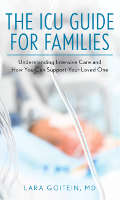
Image by Gerd Altmann
If your family member has just been admitted to the ICU, you may be overwhelmed by the number of people coming and going. Just who are all these people — and who’s in charge?
ICU care has become so complicated it requires a whole team of people, each with a different role and expertise. The good news is that your family member will benefit from having many experts involved. The downside is that communication can be challenging, and it can sometimes feel like no one person has responsibility. Sometimes everyone seems too busy to take the time to involve you.
The following are some things you should know about communicating with the ICU team.
1. You have a right to good communication
You may feel peripheral to all the action, but the fact is, you have a central role to play. You know certain things about your loved one that his new caretakers don’t — for example, symptoms over the days before hospitalization, medical history, and beliefs and values that may be important to decisions. As your loved one's advocate, you’ll need to have ongoing conversation with the ICU team, and that includes getting the explanations you need.
There’s no hard and fast rule, but during times when your family member is unstable or things are changing rapidly, it’s reasonable to expect the ICU doctor to give you an update at least every few hours. If your family member is relatively stable, expect to touch base with the doctor about once a day. The nurse should be readily available at the bedside and can answer questions and contact the doctor on your behalf. If you can’t visit because of COVID-19, good communication should still happen by cell phone or video conference.
2. There is one person in charge of the ICU team
The ICU team may be large, consisting of doctors, nurses, respiratory therapists, nutritionists, social workers, and physical therapists — to name a few. To make things more confusing, these people generally work in shifts, rotating on and off the ICU. But at any given time, there is one person with final responsibility: the “physician of record” (generally just referred to as “the ICU doctor”). This person coordinates the care given by the whole team, and she should have the best overview. Often, the physician of record works several days or weeks in a row to improve continuity. Make sure you know who she is.
3. In teaching hospitals, residents and fellows may be excellent sources of information
If you are in a teaching hospital, young doctors at various stages in training may be helping to care for your relative — including (in order of increasing seniority) medical students, interns, residents, and fellows. In some of the best teaching hospitals, residents and fellows are given considerable autonomy and responsibility — albeit under the supervision of an “attending” physician. Often they will know the details of the patient’s condition and the daily plan even better than the attending.
4. It helps to keep track of people and their roles
Because people working in the ICU are focused on their work and often in a hurry, they may or may not introduce themselves clearly. Ask every person who enters the room for his or her name and role and keep a record in a notebook.
5. It helps to appoint one person to be the spokesperson for your family
This makes it much easier for ICU staff to communicate with your family and helps to avoid mixed messages and crossed signals. The spokesperson should generally be the legal proxy for the patient, but sometimes the proxy may want to assign the role to another person. If there’s a person in the family with a medical background, that may be a good choice.
6. Knowing the schedule helps
ICU schedules vary, but there are typical times when you can get a lot of information. When a new nurse comes on duty in the morning, he or she will sometimes hear about the patient from the night nurse in “bedside report.” This is a great time to listen in and ask questions. ICU rounds involving the whole team often happen mid-morning, when perhaps as many as 10-15 people move around the ICU, stopping at each patient’s room. These rounds are generally businesslike and filled with technical jargon and aren’t a great time for questions. But you can usually get a sense of the plan for the day by listening, and you can follow up with questions to the nurse after the group moves on.
The best time for one-on-one discussions with the doctor is usually in the afternoon, after the doctor has had time to collect information, visit all the patients, and deal with any urgent issues left over from the night before. If there’s a need for an extended discussion with one or more doctors and family members, the nurse or case manager can help you to schedule a family conference.
7. It’s a good idea to give your doctor some flexibility in finding times to talk
ICU doctors are almost always busy, and the unpredictability of ICU work means they are never in full control of their schedules. Any planned activities may be cancelled or postponed as crises and urgent needs arise. Doctors are grateful to families who understand this, are respectful of their time, and leave them some flexibility.
Rather than ask the doctor to meet with you at a specific time (for example 2 pm), check when it’s generally easiest for the doctor to find time, and then tell her with plenty of notice that you’ll be available during a time range (for example, 1-4 pm). If the doctor comes into the room otherwise to check on the patient or talk to the nurse, allow her to do her work and leave quickly after maybe just one or two questions. Save longer discussions for prearranged times. (Doctors may subconsciously avoid rooms with talkative families for fear of getting “stuck” during a busy day.)
8. Your nurse is an expert
ICU nurses are not only good at providing moment to moment bedside care, they’re experts in ICU medicine. Avoid making nurses feel that only the doctor’s opinion matters or treating them like personal assistants. They are an important source of information, and also the gateway to communication with the rest of the team.
9. Photos are effective
I’ve often noted how powerful it is when family members bring in photos of my patients and hang them in the room. They remind me that this is a person — not just a patient defined by the day’s laboratory and physiologic data. In seconds, photos communicate insights into a rich life and personality: the person fishes; he has two granddaughters; he has a giant smile that makes you want to laugh. When time is short, photos provide perhaps the most efficient and effective way to humanize your loved one for the ICU team.
Copyright 2021. All Rights Reserved.
Published with permission of the author.
Book by this Author:
The ICU Guide for Families
The ICU Guide for Families: Understanding Intensive Care and How You Can Support Your Loved One
by Lara Goitein, MD
 ICU events are not uncommon but knowing what to do when a loved one is placed there is. This work explores the ICU with an eye toward guiding families to getting the best care for their beloved patient
ICU events are not uncommon but knowing what to do when a loved one is placed there is. This work explores the ICU with an eye toward guiding families to getting the best care for their beloved patient
Intensive care will touch almost all of us at some point – whether directly, or through our families and or friends. This book is for every family of patients in the ICU, who have suddenly entered an intimidating and alien world, in which they feel powerless and out of control. For readers who may be distracted and exhausted, this is a clear, accessible guide with concrete recommendations for getting the best care and asking the right questions along the way. A compassionate resource in a time of extreme stress, this book offers support to anyone touched by an ICU stay.
For more info and/or to order this book, click here. Also available as a Kindle edition.
About the Author
 Lara Goitein, MD, is a Harvard trained physician specializing in intensive care and lung medicine. She founded a clinician-directed quality improvement program at a Santa Fe, New Mexico, hospital and served as Vice President of its Medical Staff. Her professional interests include quality improvement in healthcare, end-of-life care, the training of new doctors, physician burnout, and improving communication with patients and families.
Lara Goitein, MD, is a Harvard trained physician specializing in intensive care and lung medicine. She founded a clinician-directed quality improvement program at a Santa Fe, New Mexico, hospital and served as Vice President of its Medical Staff. Her professional interests include quality improvement in healthcare, end-of-life care, the training of new doctors, physician burnout, and improving communication with patients and families.
She is an editorial board member and frequent writer for the medical journal JAMA Internal Medicine, and also writes in the lay press, including the New York Review of Books. Her new book is The ICU Guide for Families: Understanding Intensive Care and How You Can Support Your Loved One (Rowman & Littlefield, Dec. 1, 2021). Learn more at MedicalExplainer.com.






















